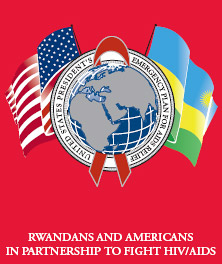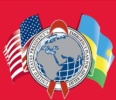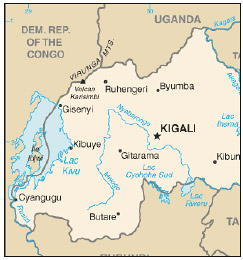| 2008 Country Profile: Rwanda PDF version PDF version

 |
|
2008 Country Profile: Rwanda
National HIV prevalence rate among adults (ages 15-49): 2.8 percent1
Adults and children (ages 0-49) living with HIV at the end of 2007: 150,0001
AIDS deaths (adults and children) in 2007: 7,8001
AIDS orphans at the end of 2007: 220,0001
Rwanda is one of PEPFAR’s 15 focus countries, which collectively represent approximately 50 percent of HIV infections worldwide. Under PEPFAR, Rwanda received more than $39.2 million in Fiscal Year (FY) 2004, $56.9 million in FY 2005, $72.1 million in FY 2006, and approximately $103 million in FY 2007 to support comprehensive HIV/AIDS prevention, treatment and care programs. PEPFAR is providing more than $123.4 million in FY 2008. | |
| Recognizing the global HIV/AIDS pandemic as one of the greatest health challenges of our time, President George W. Bush announced the President's Emergency Plan for AIDS Relief (PEPFAR) in 2003 - the largest international health initiative in history by one nation to address a single disease. The United States is changing the paradigm for development, rejecting the flawed "donor recipient" mentality and replacing it with an ethic of true partnership. These partnerships are having a global impact and transforming the face of our world today.
Partnership to Fight HIV/AIDS
The Government of Rwanda has a national HIV/AIDS action framework developed collaboratively with the U.S. Government (USG) and other major partners. The USG works with the Government of Rwanda to coordinate resources in support of the Rwanda National HIV/AIDS Strategic Plan (2005-2009), the HIV/AIDS Treatment and Care Plan (2003-2007), and the National Prevention Plan. The USG also provides advisors and technical assistance to institutions in the Office of the Minister of State for HIV/AIDS and the Ministry.
PEPFAR response in Rwanda includes:
- Building human capacity, including training medical staff and building capacity in an evolving decentralized health care system;
- Engaging new partners;
- Supporting mass media and faith-based campaigns addressing HIV risk;
- Integrating HIV prevention activities with community-based care programs;
- Assisting national drug procurement to improve procurement procedures, storage and distribution, quality assurance and quality control systems, physical infrastructure, and information systems;
- Supporting the National Tuberculosis (TB) Program to integrate TB and HIV services at health facilities throughout Rwanda; and
- Rebuilding and improving health clinics to provide antiretroviral treatment.
|
| PEPFAR Results in Rwanda |
| # of individuals receiving antiretroviral treatment as of March 31, 20081 |
|
52,400 |
| # of HIV-positive individuals who received care and support in FY2007 (including TB/HIV)1 |
|
67,700 |
| # of orphans and vulnerable children (OVCs) who were served by an OVC program in FY20071 |
|
35,000 |
| # of pregnant women receiving HIV counseling and testing services for PMTCT since the beginning of PEPFAR1,2 |
|
647,800 |
| # of HIV-positive pregnant women receiving antiretroviral prophylaxis for PMTCT since the beginning of PEPFAR1,3 |
|
26,500 |
| # of counseling and testing encounters (in settings other than PMTCT) in FY20071 |
|
629,300 |
| # of individuals reached with community outreach HIV/AIDS prevention programs that promote Abstinence and/or Being Faithful in FY2007 |
|
723,200 |
| # of individuals reached with community outreach HIV/AIDS prevention activities that promote Condoms and related prevention services in FY2007 |
|
149,500 |
| # of USG condoms shipped from Calendar Year 2004 to 2007 |
|
39,756,000 |
Note: Numbers may be adjusted as attribution criteria and reporting systems are refined. Numbers above 100 are rounded to nearest 100.
1 Total results combine individuals reached through downstream and upstream support.
2 It is possible that some individuals were counseled and tested more than once.
3 It is possible that some pregnant women received antiretroviral prophylaxis more than once over the two-year period, e.g. HIV positive women who were pregnant more than once. |
 |
PEPFAR Achievements in Rwanda to Date |
|
HIV/AIDS in Rwanda
Rwanda faces a generalized epidemic, with an HIV prevalence rate of 2.8 percent among adults ages 15 to 49.1 The prevalence rate has remained relatively stable, with an overall decline since the late 1990s, partly due to improved HIV surveillance methodology. In general, HIV prevalence is higher in urban areas than in rural areas, and women are at higher risk of HIV infection than men. Young women ages 15 to 24 are twice as likely to be infected with HIV as young men in the same age group. Populations at higher risk of HIV infection include people in prostitution and men attending clinics for sexually transmitted infections.2
Challenges to PEPFAR Implementation
Rwanda is among the world’s least developed countries, ranking 158 of 177 in the United Nations Development Program’s 2006 Human Development Index.3 Some 60 percent of the population lives in poverty. During the three months of genocide in 1994, mass rape, sexual torture and psychological trauma were common. Massive population flows following the genocide have |
|
 |
| resulted in an increase in the urban population. The shortage of human resources throughout the health sector is a significant constraint. Of Rwandans killed or displaced during the genocide, a disproportionate number were highly skilled and educated members of society, including doctors, nurses and other health workers. Many health centers lack essential physical facilities, equipment and supplies. Electricity supply is erratic throughout Rwanda, impacting hospitals, health centers and laboratories. Blood safety, data management and drug storage are all impacted by the erratic electricity supply. While stigma continues to be a problem for people living with HIV/AIDS, it would appear that the situation is slowly improving due to good information sharing at all levels about HIV/AIDS.
Critical PEPFAR Interventions for HIV/AIDS Prevention:
- Supported efforts to involve male partners in prevention of mother-to-child HIV transmission services, which has resulted in increased antiretroviral treatment enrollment, increased use of HIV counseling and testing, and improved couple communication and decision-making.
- Trained primary school teachers in faith-based, “Choose Life” curriculum, resulting in more than 15,000 boys and girls committing to abstinence.
- Supported efforts by people in prostitution and police officers to script mobile video dramas promoting abstinence, faithfulness, and the correct and consistent use of condoms among high-risk populations.
- Supported efforts to prevent stock-outs of critical blood supplies and screening reagents, once common in Rwanda. Increased the number of blood units collected and screened annually by more than 30 percent over two years.
- Coordinated medical injection safety and waste management among USG clinical partners through distribution of information, education and communications materials, procurement lists, and guidance on best practices.
Critical PEPFAR Interventions for HIV/AIDS Treatment:
- Upgraded the skills of nurses to provide HIV/AIDS treatment and care, including development of a new nursing curriculum and a pilot project to train nurses to prescribe antiretroviral drugs under physician supervision.
- Within a three-month period, supported an increase in the Rwandan Defense Forces’ monthly enrollment for antiretroviral treatment from 800 to nearly 1,200 patients.
- Supported the national roll-out of performance-based financing as an incentive for improved health care delivery at health centers and hospitals.
Critical PEPFAR Interventions for HIV/AIDS Care:
- In FY 2007, trained or retrained 4,100 individuals to provide care to orphans and vulnerable children. Organized community-based clubs to train primary school teachers and peer counselors in life skills, psychosocial care, and HIV/AIDS prevention for orphans and vulnerable children.
- Supported efforts of associations of people living with HIV/AIDS to meet nutritional and financial needs through income generation projects.
- Built the capacity of local organizations to manage and implement HIV/AIDS care programs on a decentralized basis through consultations with key stakeholders, and assistance with planning and training development.
1 UNAIDS, Report on the Global AIDS Epidemic, 2008.
2 WHO, Summary Country Profile on HIV/AIDS Treatment Scale-up – Rwanda, 2005.
3 United Nations Development Programme, Human Development Report, 2006. |
| |  |  |




 PDF version
PDF version